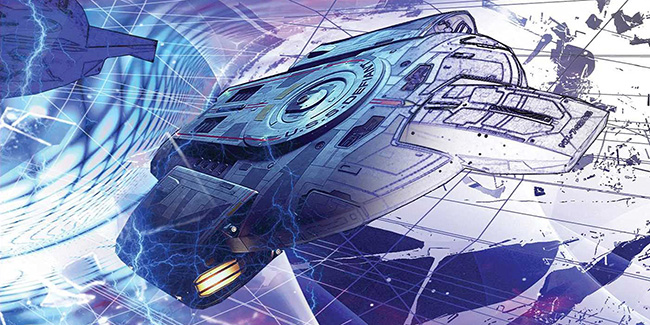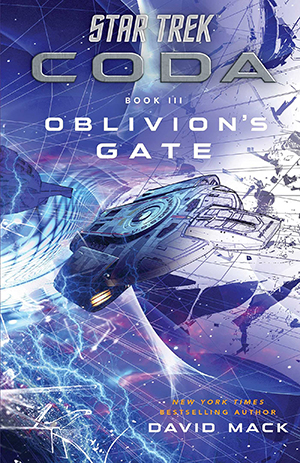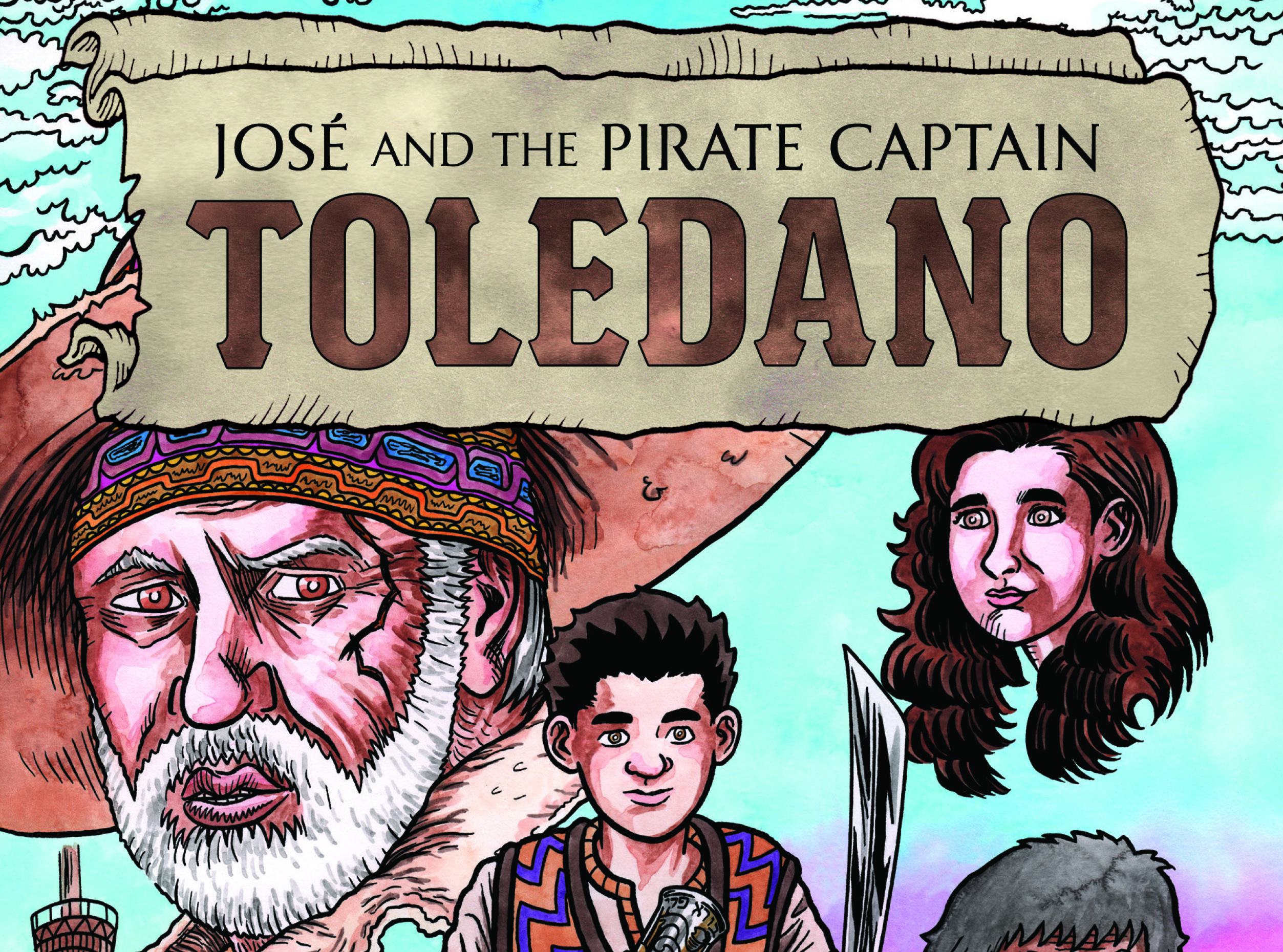
Star Trek Coda: Book Three: Oblivion’s Gate
 With David Mack’s Star Trek Coda: Book Three: Oblivion’s Gate, the two-decades-old Star Trek literary universe comes to an end. This Coda series has gotten better and better as it’s gone on. I enjoyed book one, Moments Asunder by Dayton Ward, and I thought book two, The Ashes of Tomorrow by James Swallow, was even better. This final novel, Oblivion’s Gate, is easiest the best of the bunch.
With David Mack’s Star Trek Coda: Book Three: Oblivion’s Gate, the two-decades-old Star Trek literary universe comes to an end. This Coda series has gotten better and better as it’s gone on. I enjoyed book one, Moments Asunder by Dayton Ward, and I thought book two, The Ashes of Tomorrow by James Swallow, was even better. This final novel, Oblivion’s Gate, is easiest the best of the bunch.
David Mack is one of my very favorite Trek authors, and he’s crafted a great book here. Oblivion’s Gate is a dense story, packed-full of characters and situations. Mr. Mack has done his best to incorporate as many characters as possible from the Star Trek literary universe, including characters from all the 24th-century Star Trek series (including Next Generation, Deep Space Nine, and Voyager) as well as many characters who have been created over the years in the novels. Mr. Mack does a good job at giving so many of these characters who I know and love their small moments, without ever allowing the story to get too unwieldy or too confusing with too many characters. Most importantly, this is a rollicking adventure story that moves along at an incredible pace. Mr. Mack has always been great at writing page-turner novels with exciting sustained tension, and while I thought the first two Coda books were occasionally a little light on exciting suspense and tension, this book is a barn-burner in which the momentum just builds and builds and builds. I was happy that, finally, our heroes aren’t just playing aimless defense, but actually have a plan and go on the offensive. Mr. Mack always writes great action; and I loved the structure of the story here withe exciting parallel action unfolding with the Defiant on the Borg-assimilated Earth while Mirror Luc Picard and the jaunt ship Enterprise in the “First Splinter” timeline are trying to evade Riker and the Titan who are on the hunt for them.
While I liked the idea in theory of bringing back the Devidians (the alien villains from the TNG “Time’s Arrow” two-parter) and expanding upon them, I felt they were underwhelming as the “final” villains of the Trek lit-verse. These faceless aliens just didn’t have the personality to feel BIG enough to warrant being the unbeatable threat that brought down our heroes and this entire timeline. They just didn’t feel interesting enough or dangerous enough. I loved the idea in this novel that back in First Contact, the Borg on the assimilated Earth (glimpsed by Picard & co. briefly after the Queen goes back in time and changes history) would have detected the Enterprise and the time-warp and tried to stop them. That’s a cool hook for a story. I wonder if it would have been better to lead with that from the start of this series, rather than keeping it as a surprise for book three? I think I’d have been more excited for this story had the Borg been involved earlier.
I am pleased that this Coda series exists, and that extended novel series has been given a proper conclusion as opposed to just being abandoned (as I feared might happen when the Star Trek books went on hiatus a few years back, or when Mr. Mack’s own 2020 novel Collateral Damage seemed to quickly wrap a lot of things up). Still, I absolutely hate that the dumb Star Trek: Picard show has resulted in the end of this brilliant series of interconnected Star Trek novels that I have been following for so long.
For years — ever since it became clear that the Picard show’s continuity was going to dramatically contradict the continuity of this book series — I’ve been worried about what would happen and, if this book series had to end, whether this long-running series would be brought to a satisfying conclusion. That was the most important aspect for me of this Coda series.
In the end, my verdict is mixed. David Mack, Dayton Ward, and James Swallow made certain fundamental choices that I don’t love. They decided to craft a “going down in a blaze of glory” ending. That’s not what I wanted. The events of Coda basically end up with wiping out the timeline of the Star Trek novels and replacing it with the events of Picard as the new “prime” timeline. While I understand that the events of the official Trek TV shows and movies — however much I might dislike them — are always going to be considered the “real” versions of events, as opposed to any tie-in media, it was painful to me to see the book continuity — which depicted a far better thought-out and far more satisfying version of what became of our beloved TNG characters than what we saw in Picard — wiped out and replaced by the Picard timeline. I would have strongly preferred for the writers to have allowed both continuities to exist side by side. Even if there weren’t going to be any more novels in this continuity we’ve been following for the last twenty years, I wanted to imagine that, after the final page of the final book, that the lit-verse continuity was still going on, that our characters were continuing to go on further adventures — just ones we wouldn’t be reading — and that they would be allowed to have a happy ending. That’s not the path these authors chose, and that bums me out.
I’d been afraid that’s where this story was going ever since Coda book one. But there were several times in Mr. Mack’s novel in which I saw hints of hope that maybe it was all a fake-out and that, in the end, Picard & co. would find a way to preserve the lit-verse timeline. Even the finale chapter — a wonderfully enigmatic tour through the life of Jean-luc Picard, apparently across many timelines — hinted that Picard’s memory of the lit-verse timeline might be preserved. I wish the ending had actually gone there and given us a happy ending for this timeline and these characters. I’m disappointed that didn’t happen.
More thoughts:
* This book was packed with wonderful small character moments. I particularly loved the Worf-K’ehleyr stuff. I’d felt Worf had gotten short-shrifted in the previous two books, so I loved him getting more attention here, and it was an unexpected delight to see this wonderful relationship from early TNG revisited.
* I was so happy that the Mirror Universe characters — which were wonderfully explored over many novels in this lit-verse — were so centrally involved. I loved getting to see more of Mirror Barclay and Luc Picard, and also Mirror Saavik. (I loved the Saavik-Spock stuff — I wish we’d gotten even more!) I liked the reference to Empress Sato (from the Enterprise mirror-universe two-parter “In a Mirror, Darkly”). I loved seeing Mirror Luc meet Beverly Crusher. I loved meeting Mirror Eddington.
* The “Shut up Wesley” joke made me laugh. A lot. (But the book loses a few points for gilding the lily and repeating the joke a second time.)
* I loved seeing Captain Sonya Gomez!! (It’s fun that she’s here and that she also appeared in Lower Decks season two!)
* Mr. Mack’s heart was in the right place in referencing Discovery, but I thought Spock’s mention of his sister Michael was awkward. (That says more of my dislike for Discovery than it’s any criticism of Mr. Mack’s writing.)
* I like the meaning this book’s story gives to the Coda title.
* I’ve been complaining for years that the Trek books abandoned the story of Prynn Tenmei and Shar. I loved the quick nod here in this book to their being together in the Mirror Universe. I’ll take it.
* I loved seeing the mention of Mackenzie Calhoun!! (He’s the lead character in Peter David’s New Frontier series of novels.)
* It didn’t make sense to me that all the singularities Luc is investigating — which could by anywhere in the Milky Way galaxy!! — could all be reached by his Enterprise within less than twelve hours. The reference to “natural transwarp currents” doesn’t make any sense to me as an actual explanation.
* I liked reading the mentions of the Caeliar from Mr. Mack’s Destiny trilogy. I was intrigued to read the suggestion that the Borg might have used time travel to create paradoxes and multiple conflicting origins for themselves. That’s a great way to future-proof why Trek stories in the future might present a different picture of the Borg’s origins from the Caeliar story in Destiny. This novel establishes First Contact as the divergent point between the Trek lit-verse and the main Picard continuity. But the origin story of the Borg, as depicted in Destiny, took place long before First Contact and so that wouldn’t be undone by the end of this lit-verse. However this suggestion that the Borg’s (mis)use of time travel might have created multiple paradoxical origins for themselves explains how future Trek shows/movies could choose to present a different origin for the Borg. Very clever!
* Sisko’s death was a big letdown for me. The book makes him seem foolish for not allowing Bashir to properly cover him. Why did Mr. Mack make that choice?
* On the other hand, I loved the beautiful and moving goodbye scene between Geordi and Data. It was the scene Nemesis didn’t give us (but should have). (By the way, the same goes for the end of Picard season one. The TNG movies and Picard made it seem like Picard and Data were sort of soulmates, and I do love their relationship, but it was Geordi and Data who had the closest friendship throughout seven seasons of TNG.)
* I wonder why the Voyager characters didn’t have a major role to play in Coda? (I’m a few books behind on Kristen Beyer’s Voyager novels, so maybe the ending of those stories took the Voyager characters out of play?)
…
So, that’s it. We’re at the end. I am bummed. I will miss these novels. I understand why this two-decade continuity had to end, while also wishing the folks at Paramount and Simon & Schuster could have found a way for these stories to continue, in parallel with new stories set in the Picard continuity. I mean, they’ve found a way to continue to publish Original Series books despite the J.J. Abrams movies creating a new continuity! So why couldn’t the same have been done here?
I’m not sure what’s next for me. I’m sure I’ll continue to read future Trek novels, though I must confess the end of this series leaves me feeling untethered, and I’m not that interested in what few new Trek books have been announced for the coming months. I do still have a pile of Trek novels from the past several years that I’d hadn’t found time to read yet — mostly stand-alone stories, plus Kristen Beyer’s final Voyager books, and a few others — so I will definitely find time to read those. After that, who knows? Maybe I’ll take the time to go back and re-read some of the great Trek books from the last few decades that I’ve been wanting to revisit! That’s an encouraging thought. I’m sad this continuity is over… but wow, how amazing is it that this twenty-year extended story exists?!! There are so many books that will be so fun to go back and re-read someday!!! And I do have hope that some of the Trek authors who I love will find ways to continue writing good new Trek novels, even if they’re not connected to this particular continuity. We’ll see.
For now, adieu. Thank you to all of the writers and editors who have been responsible for creating this epic saga, one of the greatest sci-fi literary series I have ever had the pleasure to read.
Click here to pre-order my graphic novel José and the Pirate Captain Toledano!
Click here to purchase my “Maclunkey” Star Wars/Highlander mash-up t-shirt!
Please support MotionPicturesComics.com by clicking through one of our Amazon links the next time you need to shop! As an Amazon Associate, I earn from qualifying purchases. That means I’ll receive a small percentage from any product you purchase from Amazon within 24 hours after clicking through. Thank you!
Previous Star Trek novel reviews:
Star Trek – Unspoken Truth , Troublesome Minds, Cast No Shadow, Excelsior: Forged in Fire, Allegiance in Exile, Legacies Book 1: Captain to Captain, Legacies Book 2: Best Defense, Legacies Book 3: Purgatory’s Key, The Face of the Unknown, From History’s Shadow, Elusive Salvation, Assignment: Eternity, The Rings of Time, The Weight of Worlds, No Time Like the Past, Foul Deeds Will Rise, The Antares Maelstrom, The Shocks of Adversity, Crisis of Consciousness, The Latter Fire, Serpents in the Garden
Star Trek: The Next Generation – A Time to be Born & A Time to Die, A Time to Sow & A Time to Harvest, A Time to Love & A Time to Hate, A Time to Kill & A Time to Heal, A Time for War, a Time for Peace, Death in Winter, The Sky’s The Limit, Resistance and Q & A, Before Dishonor and Greater than the Sum, Destiny trilogy, A Singular Destiny, Losing the Peace, Immortal Coil, Cold Equations Book 1: The Persistence of Memory, Cold Equations Book 2: Silent Weapons, Cold Equations Book 3: The Body Electric, The Light Fantastic, Takedown, Armageddon’s Arrow, Prey Book 1: Hell’s Heart, Prey Book 2: The Jackal’s Trick, Prey Book 3: The Hall of Heroes, Headlong Flight, Hearts and Minds, Available Light, Collateral Damage, Coda Book 1: Moments Asunder, Coda Book 2: The Ashes of Tomorrow
Star Trek: Deep Space Nine – DS9 relaunch overview, The Soul Key, The Never-Ending Sacrifice, Plagues of Night and Raise the Dawn, Section 31: Disavowed, The Missing, Sacraments of Fire, Ascendance, Force and Motion, The Long Mirage, Section 31: Control, Enigma Tales, Gamma: Original Sin
Star Trek: Voyager – Full Circle, Unworthy, Children of the Storm, The Eternal Tide, Protectors
Star Trek: Enterprise — Kobayashi Maru, The Romulan War: Beneath the Raptor’s Wing, The Romulan War: To Brave the Storm, Rise of the Federation: A Choice of Futures, Rise of the Federation: Tower of Babel, Rise of the Federation: Uncertain Logic, Rise of the Federation: Live By the Code, Rise of the Federation: Patterns of Interference
Star Trek: Titan – Book 1: Taking Wing, Book 2: The Red King, Book 3: Orion’s Hounds, Book 4: Sword of Damocles, Under a Torrent Sea, Synthesis, Fallen Gods, Absent Enemies (e-book), Sight Unseen, Fortune of War
Star Trek: Typhon Pact – Book 1: Zero-Sum Game, Book 2: Seize the Fire, Book 3: Rough Beasts of Empire, Book 4: Paths of Disharmony, The Struggle Within (e-book), Plagues of Night and Raise the Dawn, Brinkmanship
Star Trek: The Fall — Book 1: Revelation and Dust, Book 2: The Crimson Shadow, Book 3: A Ceremony of Losses, Book 4: The Poisoned Chalice, Book 5: Peaceable Kingdoms
Star Trek: New Frontier – Series overview, Stone & Anvil, After the Fall, and Missing in Action, Treason and Blind Man’s Bluff
Star Trek: Department of Temporal Investigations – Watching the Clock, Forgotten History, The Collectors (e-book), Time-Lock (e-book), Shield of the Gods (e-book)
Star Trek: The Lost Era – Book 1: The Sundered (2298), Book 2: Serpents Among the Ruins (2311), Book 3: The Art of the Impossible (2328-2346), The Buried Age (2355-2364), One Constant Star (2319)
Star Trek: Mirror Universe (Books 1 & 2) – Star Trek: Mirror Universe: Shards & Shadows – Star Trek: Mirror Universe: The Sorrows of Empire — Star Trek: Mirror Universe: Rise Like Lions – Star Trek: Myriad Universes (Books 1 & 2) – Star Trek: Myriad Universes: Shattered Light
Beyond the Final Frontier — Josh’s favorite Star Trek novels


